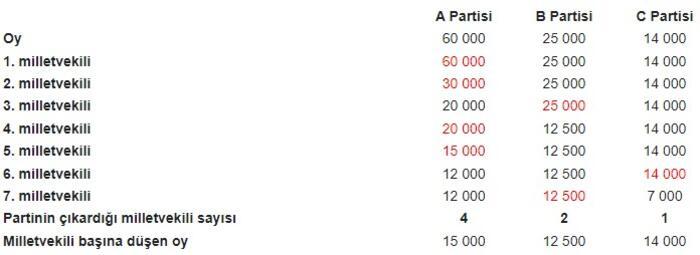
What is the D’Hondt electoral system, what does it mean? D’Hondt system calculation examples
One of the issues that came up with the election law was the D’Hondt system, which was planned to be used in parliamentary calculations. So, how are calculations made according to this system and how does the system work?
What is the D’Hondt system, what does it mean?
The D’Hondt system is a proportional representation system designed by the Belgian jurist and mathematician Victor D’Hondt in 1878. In Turkey, the d’Hondt system has been applied in all parliamentary general and by-elections since 1961, with the exception of the 1965 National Assembly general election and the 1966 National Assembly by-election; This is the system still in effect today.
Argentina, Austria, Belgium, Bulgaria, Czech Republic, East Timor, Ecuador, Finland, Wales, Croatia, Scotland, Israel, Iceland, Japan, Colombia, Hungary, Macedonia, Paraguay, Poland, Portugal, Romania, Serbia, Slovenia, Chile, It is the election method applied in the TRNC and Turkey.
D’Hondt system calculation examples
The total votes received by each party in a constituency are divided by 1, 2, 3, and 4, respectively, and this process is continued until the number of deputies to be elected by that constituency is reached. The obtained shares are ordered from the largest to the smallest, regardless of the lot. Parliamentary seats are allocated to the parties according to this order. In a constituency that will elect 7 deputies, Party A gets 60 000 votes, Party B gets 25 000 and Party C gets 14 000 votes.


A new era in the ballot box: Türkiye will use this system for the first time! Here is the new proxy account…

This news has been translated by google translate.
Artificial intelligence has reinterpreted this news for you.
The D’Hondt system is a proportional representation system designed by Belgian jurist and mathematician Victor D’Hondt in 1878. It has been used in all parliamentary general and by-elections in Turkey since 1961, except for the 1965 National Assembly general election and the 1966 National Assembly by-election. The system is still in effect today and is used in countries such as Argentina, Austria, Belgium, Bulgaria, Czech Republic, East Timor, Ecuador, Finland, Wales, Croatia, Scotland, Israel, Iceland, Japan, Colombia, Hungary, Macedonia, Paraguay, Poland, Portugal, Romania, Serbia, Slovenia, and Chile.
In the D’Hondt system, the total votes received by each party in a constituency are divided by 1, 2, 3, and 4, respectively, and the process continues until the number of deputies to be elected by that constituency is reached. The obtained shares are then ordered from the largest to the smallest, regardless of the lot. Parliamentary seats are allocated to the parties according to this order. The system has been a topic of discussion in Turkey due to recent changes in the election law, which planned to use the D’Hondt system in parliamentary calculations.


